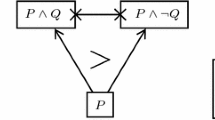Abstract
How should we evaluate an argument in which two witnesses independently testify to some claim? In fact what would happen is that the testimony of the second witness would be taken to corroborate that of the first to some extent, thereby boosting up the plausibility of the first argument from testimony. But does that commit the fallacy of double counting, because the second testimony is already taken as independent evidence supporting the claim? Perhaps the corroboration effect should be considered illogical, since each premise should be seen as representing a separate reason in a convergent argument for accepting the claim as plausible. In this paper, we tackle the problem using argumentation schemes and argument diagramming. We examine a number of examples, and come up with two hypotheses that offer methods of analyzing and evaluating this kind of evidence.













Similar content being viewed by others
Notes
Many of the issues discussed relate to questions studied in a recent paper on argument evaluation (Goddu 2003), but we have no space to comment on them specifically, in order to fit the length requirements.
Helpful discussions of how these tools are proving to be important both in artificial intelligence and law are provided in (Reed and Norman 2003).
The original version of the clock and gun case can be found in (Walton 1984, p. 16).
At any rate, it would make it stronger, and let’s say that in the kind of case we are considering, depending on how we are rating argument strength by some standard, it would make it very strong.
References
Goddu, G.C. 2003. Against the “Ordinary Summing” test for convergence. Informal Logic 23(3): 215–236.
Gordon, Thomas F., Henry Prakken, and Douglas Walton. 2007. The carneades model of argument and burden of proof. Artificial Intelligence 171: 875–896.
Redmayne, Mike. 2000. A corroboration approach to recovered memories’. Law Quarterly Review, 116, 147–155.
Reed, C.A., and T.J. Norman. 2003. Argumentation machines. Dordrecht, Holland: Kluwer.
Reed, C., and G. Rowe. 2004. Araucaria: software for argument analysis, diagramming and representation. International Journal on Artificial Intelligence Tools 13(4): 961–980. (Available at http://araucaria.computing.dundee.ac.uk/).
Reed, C., and D. Walton. 2005. Towards a formal and implemented model of argumentation schemes in agent communication. Autonomous Agents and Multi-Agent Systems 11: 173–188.
Verheij, B. 2003. Dialectical argumentation with argumentation schemes: an approach to legal logic. Artificial Intelligence and Law 11: 167–195.
Walton, D. (1984). Logical dialogue-games and fallacies. Lanham, Maryland: University Press of America. (Available free at http://io.uwinnipeg.ca/~walton/books/LDG84bk.pdf).
Walton, D. 1997. Appeal to expert opinion. University Park, PA: Penn State University Press.
Walton, D. 2005. Argumentation methods for artificial intelligence in law. Berlin: Springer (Lecture Notes in Artificial Intelligence Series).
Walton, D., and T.F. Gordon. 2005. Critical questions in computational models of legal argument. In International Workshop on Argumentation in Artificial Intelligence and Law, ed. Paul E. Dunne and Trevor Bench-Capon, 103–111. Nijmegen: Wolf Legal Publishers. (Available on web page http://io.uwinnipeg.ca/~walton/books/LDG84bk.pdf).
Wigmore, J. H. 1913. The principles of judicial proof as given by logic, psychology and general experience and illustrated in judicial trials. Boston: Little, Brown and Company.
Author information
Authors and Affiliations
Corresponding author
Rights and permissions
About this article
Cite this article
Walton, D., Reed, C. Evaluating Corroborative Evidence. Argumentation 22, 531–553 (2008). https://doi.org/10.1007/s10503-008-9104-0
Received:
Accepted:
Published:
Issue Date:
DOI: https://doi.org/10.1007/s10503-008-9104-0




